
Features
Crop Culture
Inputs
Growing in the Green: A merry season for poinsettias
February 4, 2009 By Melhem Sawaya
The week of Nov. 10-15 usually arrives, and the only pot plant that is somewhat in demand is poinsettia. Every other flowering crop, from November to December, see a drastic decline in sales. Stores are only carrying the basic products for a certain occasion and, without a doubt, poinsettia is the Christmas flower.
The week of Nov. 10-15 usually arrives, and the only pot plant that is somewhat in demand is poinsettia. Every other flowering crop, from November to December, see a drastic decline in sales. Stores are only carrying the basic products for a certain occasion and, without a doubt, poinsettia is the Christmas flower.
Poinsettia production for 2008 was very close to what it had been in 2007, and even with the slow sales start, the season finished well. Most, if not all, growers sold all they grew. There was even demand the last week of shipping, when the needed product couldn’t be immediately found by some Ontario growers.
In general, the prices for the grower were six to 10 per cent higher than last year. If you didn’t get an increase in price in 2008, it was due to one of two things – either you never asked for one, or you asked for an increase but your buyer didn’t want to listen to your explanations about the increasing costs of production.
Even if it is hard to find new customers, sticking with a buyer unwilling to work with you is not an option because the consequences are worse and will lead to business failure.
Having said this, the majority of buyers understand costs, selling prices and margins, and communicate with their grower/supplier to make this a crop that growers don’t mind producing.
A BETTER SEASON IN ONTARIO THAN EXPERIENCED IN ’07
Considering the economic situation, the 2008 poinsettia season was much improved over 2007, and certainly much better than the 2003 season when production numbers were three times what they are now.
The rule of supply and demand always works. Only growing what consumers can use along with working to increase demand through promotional programs is the right way to manage any market. Growing a crop and then finding someone to buy it is an old business practice, and one that is doomed to fail.
We learned our lesson and are producing only what is ordered, or very close to it. In other words, supply equals demand!
Making many small shipments to the stores, rather than one large delivery, enhances poinsettia quality at retail. What you want to avoid is having the crop sit for long periods at the stores in much less favourable conditions than available in the greenhouse.
Poinsettias delivered before Nov. 15 last fall did not sell quickly, which created a slowdown in shipping. This caused many problems due to shelves full of plants receiving little maintenance for seven to 12 days, by which time they are almost dead but still occupying precious selling space. Growers and buyers who communicated properly on this issue have done well. Half-dead plants on sale for a dollar or less are poor promotions for any live product. Very small shipments early in the season – and watching the sell-through and ramping up accordingly – are important factors for a win-win situation for retailers and growers.
Large-size pots last longer at the store level, which translates to less shrinkage – specifically where plant maintenance at the store level is forbidden.
Since early sales were slow, the 4-1/2” pot size didn’t do very well last season, even though the numbers were cut drastically from 2007. Normally, 4-1/2” containers are good for early sales.
Effective packaging enhances the product. Minimal packaging is only a tax on your costs without doing anything to improve the product.
Demand for painted poinsettias has almost completely disappeared. Consumers learned the side-effect of the spray paint is that it reduces shelf life by from 50 to 90 per cent.
A HIT OR MISS SEASON FOR PLANT FUNDRAISERS
Fundraisers are flourishing for some and not paying off for others. The main difference is how to manage the programs and cut costs in every transaction, because with the bigger programs, the higher number of transactions leads to significant costs. Normally, the cost to supply fundraisers is somewhat higher than large wholesale orders, but if the extra cost is not managed, then we are back to square one with no profit.
Brokering of poinsettias showed a tiny increase last fall due to two factors:
• The Canadian dollar.
• Many garden centres that do fundraisers, or other large growers that don’t want to grow poinsettias but like to keep in contact with their buyer, bought some plants from other growers.
Poinsettia tree sales are down, either due to their high ticket price or because many people are purchasing smaller cars and they have no way of taking the tall poinsettia trees home. Is there a place for a smaller tree?
A crop mix of 70 per cent red and 30 per cent other colours seems to be a good ratio. White plants in large pot sizes could be increased just a little. ‘Cortez Burgundy’ is losing ground drastically. Consumer dissatisfaction is catching up. Also, the Winter Rose series is on a downturn as its novelty is wearing out.
ARE THERE TRUE SAVINGS IN GROWING THE CROP COOL?
Here are some observations from the production point of view:
• The biggest confusion in production last fall was with efforts to grow the crop cooler. I always suggest that whenever you are trying a new variety or procedure, do it on a small scale at first. Some growers, however, followed the advice that suggested you can save money by growing poinsettia cool. However, the advice focused more on what you can save, and did not talk a lot about potential pitfalls. Some of the side-effects were:
Poinsettias that were much too tall because they were started two to three weeks earlier than normal.
Treating the crop with more growth regulator than normal, due to having it started earlier, which leads to smaller bracts. Rather than saving on fuel bills, this required higher than normal heating at the end of the crop, which defeated the idea of saving on energy.
Starting the crop two to three weeks earlier, even if it is in the summer, costs money as heat is not the only expense. Labour, fertilizers and time all translate into higher cost.
• Growers with the most profitable poinsettia crops are those who grow the right variety for the right pot size and who do not try to stretch a short variety by growing it longer or by over-treating a tall variety with growth regulators to try to make it fit into a small pot size. Of course, these profitable growers did everything on time according to what the crop program called for, and adjusted with Mother Nature to meet their pre-determined specs of the finished product.

|
|
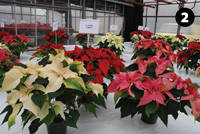 |
|
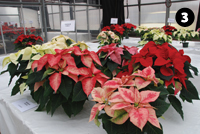
|
|
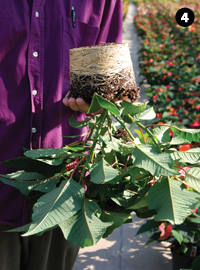 |
|
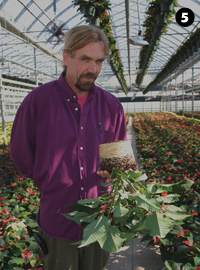 |
|

|
|
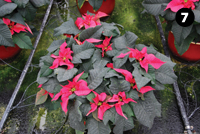
|
|
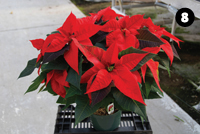
|
|
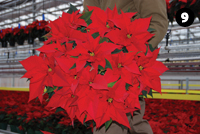 |
|
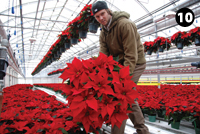 |
|
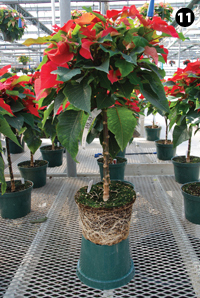 |
|
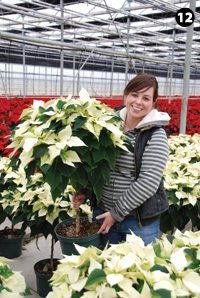
|
|

|
|
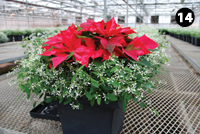
|
|
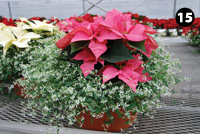 |
|
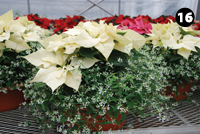
|
|
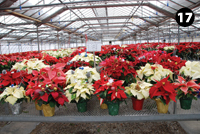 |
|
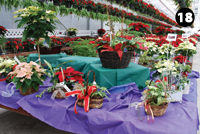
|
|

|
|

|
|
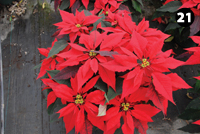
|
|
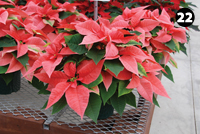
|
|
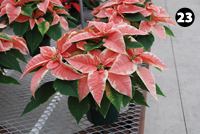
|
|
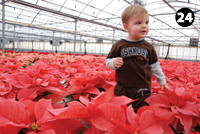
|
|

|
TAKE A FEW ROAD TRIPS TO CHECK OUT “WHAT’S NEW!”
Visiting trial sites and with other growers, and attending conferences, are important to help you keep up with what is new or improved with either variety or production ideas. We are fortunate in Ontario, because OMAFRA greenhouse floriculture specialist Wayne Brown (1) co-ordinates a poinsettia trial of more than 100 varieties at the Vineland Research and Innovation Centre each fall.
It is confusing knowing what to grow when you see all these colourful varieties; attending these trials with your questions can only help. For example, if you’re looking for a new white variety for 12” pots, or pink variety for 4” pots, then you can focus your requirements and come up with some answers from these trials.
The Classic family (2) looks very good and I have been closely following the performance of this variety with other growers. It is good for large pots because of its vigorous growth habit, and as well for 6” pots due to the ease of controlling its growth habit.
The Premium family (3) is excellent for 4” to 6” pots. Its wide selection of colours and compact habit make it a favourite with consumers and profitable for retailers.
What especially grabbed my attention this past poinsettia season was ‘Polly Pink,’ a deep pink poinsettia. The most remarkable feature is its roots (4). Mark Healey, at Lakeshore, (5) is impressed with the Polly’s roots; the crop was grown on flood floors. Also, Nathan Nauta from Jeffrey’s Greenhouses (6) likes the root habit; they grew this variety on drip irrigation. In talking with another grower, the ‘Polly Pink’ didn’t develop proper bracts as it is extremely responsive to growth regulators, especially if drenched.
This crop (7) was drenched with 1,000 ppm Cycocel once, early in the crop. My guess is the roots are extremely efficient in taking up Cycocel, because sprays with Cycocel didn’t have the same extreme effects, but performed much like other varieties, such as ‘Prestige.’ ‘Classic Red’ (8) looked good in many greenhouses, even if it was grown in limited numbers. The 8” Classic (9) looked good, and Jeremy Van Koeveringe, at Spring Valley (10), liked the evenness of the bracts, ease of production, and its general performance.
POINSETTIA TREE DEMAND NOT WHAT IT USED TO BE
As we said, poinsettia tree demand is on the decline, even though the product looked as good as ever. It takes a long time to grow a poinsettia tree and the soil texture is less than desirable as the oxygen content in the soil media is diminished drastically. However, growers who water by hand help new roots (11) because watering by hand drives oxygen to the root ball.
Excellent quality trees that Shawna Hardman (12) of Lakeshore helped produce had a challenging time finding homes last season.
‘Ice Punch,’ (13) which was exclusive to National Grocers, made a great hit. Mind you, it is new and available in limited numbers, but the reaction from consumers has been positive.
Mixing other cultivars with poinsettia is not new, but mixing ‘Diamond Frost’ or ‘Ice Punch’ (14), with a pink poinsettia (15), or a white poinsettia (16) is new. The combination of any colour with ‘Diamond Frost’ is good, but consumer response is hesitant, especially if they had this product in their home on a coffee table over a deep pile carpet, because they will have an interesting time vacuuming flowers from the carpet as they fall continuously. My mother-in-law solved this problem very quickly. After four to five days of cleaning up dropped flowers, she took the plant shears to the ‘Diamond Frost’ and cut them off at soil level! (A good-looking product … but not practical.)
Some upgrading (17), (18) will offer choices with the same product in different packaging that will interest different customers. The beauty of this concept is that the upgrading is done on a demand basis and we are not stuck with a large volume of product that might not go anywhere.
Different people have favourites for different reasons but, in general, everything works well, production-wise, and has good consumer appeal.
Rick Rabb at C.F. Greenhouses (19) likes ‘Euro Glory’ for his production.
At Yoder, they grow many 4-1/2” varieties, but Dennis Noland, Henry Vallier and Rob Bigley (20) like their ‘Prestige,’ which accounts for over 50 per cent of the 4-1/2” crop.
Some varieties have a good record of being easy to grow and enjoying considerable consumer appeal. Three to mention are ‘Freedom Firework’ (21), ‘Maren’ (22), and ‘Marble Star’ (23). They all have excellent shelf life and are fairly easy to produce.
It’s also worth noting that if plants don’t give enjoyment to parents and kids, then no one will buy them. Knowing that, why don’t we promote plant enjoyment rather than just plants? I took these pictures of Riley Stigter of Warren Greenhouses (24), and Nathan and Jennifer Huck of Colour Paradise Greenhouses (25) to demonstrate the joy that kids have in being among flowers and the cheerfulness flowers bring to their parents. We have the responsibility to educate the consumer about the power of flowers to enhance their life and the benefits of flowers, rather than just
promoting a red, white or pink flower!
Print this page